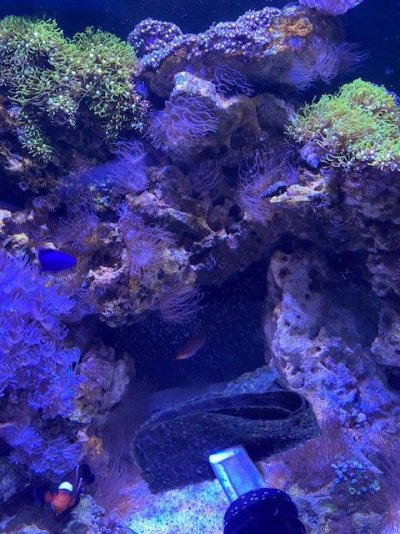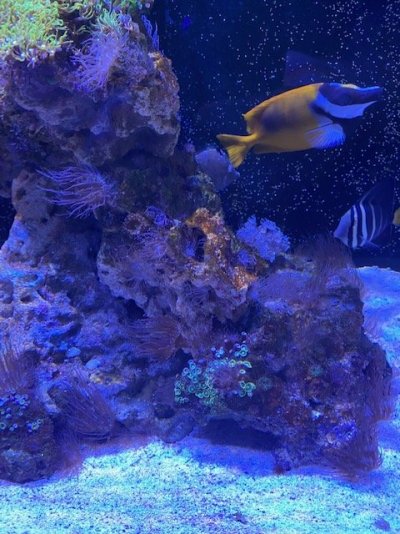Well here's my tank. It's a red sea 250. I don't think any of you have the problem as bad as I do, so if someone has the cure for aptasia, people like me are prepared to make you a trillion-aire. With the caviet we get to sue you 10-times over if it doesn't work. The fact is, EVERY coral, fish, etc you buy has aptasia and majano. Anyone who tells you otherwise is lying. They are the one thing that will take over your tank before anything else--only takes about 3 weeks to 2 months before you're ready to give up. As for anyone telling you that ANTYHING works for aptasia or majano, jsut walk away politely and then go tell everyone else they're full of it. Here's the fact--NOTHING WORKS! It's a so called "problem" that is making money for snake oil salesman.
Here's what I've tried, just to prove a point. The "magic cures" have cost me as much as the tank itself, so I have first hand experience as to what doesn't work:
1) Filefish--does absolutely nothing except swim vertically and its' fins are pretty cool.
2) Peppermint shrimp--5 different batches over the past year. They do absolutely NOTHING other than cost around $15 for each shrimp. Then after they walk around the tank, they get into a one-rock situation and sit there rocking side to side. If you ever want to try nudibranches, then you're screwed--peppermint shrimp eat them.
3) Aptasia-X Yep, the Red Sea brand. It also does absolutely NOTHING except cause the old aptasia to release spores. Those spores then get into the rest of your tank.
4) Burghia Nudibranch--Tried $200 worth, got 12. Never did anything and have been in the tank for over 2 months.
5) Copperband--Don't work either. About the only thing I'll say is at least they have a cool nose.....
6) Six-line wrasse--Swim around the rocks and dodge the foxface and other tangs in your tank.
7) Removing ALL live rock and using a pastry torch to burn away everything on the rock--even the algae. Worked for a week, then everything was back even worse than before.
8) Lemon juice--Kind of works for a week, but it changes PH/ALK so fast you'll be reaching for your soda ash.
9) Kalwasser--I saw this on BRS TV and thought about it for a minute. It's basically the same thing as Aptasia-X. It changes your alkalinity, and then clouds your water while flipping your PH.
10) Clipping the bigger ones with tweezers--they come back even worse than before.
11) Joe's Juice---IT"S JUST FANCY LEMON JUICE!!
So, yeah, been there and done that. If anything new that comes out DOES work, I'd probably be the one who would try it out. Nothing else on the list for me to try. I'm at the point of just let nature take it's course. Eventually the aptasia will balance out the rest of the corals and they can sting themselves into submission.
Only the fittest will survive, and if the $5000 worth of corals win over the free aptasia problem I've inherited, so be it.
Here's what I've tried, just to prove a point. The "magic cures" have cost me as much as the tank itself, so I have first hand experience as to what doesn't work:
1) Filefish--does absolutely nothing except swim vertically and its' fins are pretty cool.
2) Peppermint shrimp--5 different batches over the past year. They do absolutely NOTHING other than cost around $15 for each shrimp. Then after they walk around the tank, they get into a one-rock situation and sit there rocking side to side. If you ever want to try nudibranches, then you're screwed--peppermint shrimp eat them.
3) Aptasia-X Yep, the Red Sea brand. It also does absolutely NOTHING except cause the old aptasia to release spores. Those spores then get into the rest of your tank.
4) Burghia Nudibranch--Tried $200 worth, got 12. Never did anything and have been in the tank for over 2 months.
5) Copperband--Don't work either. About the only thing I'll say is at least they have a cool nose.....
6) Six-line wrasse--Swim around the rocks and dodge the foxface and other tangs in your tank.
7) Removing ALL live rock and using a pastry torch to burn away everything on the rock--even the algae. Worked for a week, then everything was back even worse than before.
8) Lemon juice--Kind of works for a week, but it changes PH/ALK so fast you'll be reaching for your soda ash.
9) Kalwasser--I saw this on BRS TV and thought about it for a minute. It's basically the same thing as Aptasia-X. It changes your alkalinity, and then clouds your water while flipping your PH.
10) Clipping the bigger ones with tweezers--they come back even worse than before.
11) Joe's Juice---IT"S JUST FANCY LEMON JUICE!!
So, yeah, been there and done that. If anything new that comes out DOES work, I'd probably be the one who would try it out. Nothing else on the list for me to try. I'm at the point of just let nature take it's course. Eventually the aptasia will balance out the rest of the corals and they can sting themselves into submission.
Only the fittest will survive, and if the $5000 worth of corals win over the free aptasia problem I've inherited, so be it.






























